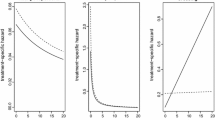Abstract
The choice of multi-state models is natural in analysis of survival data, e.g., when the subjects in a study pass through different states like ‘healthy’, ‘in a state of remission’, ‘relapse’ or ‘dead’ in a health related quality of life study. Competing risks is another common instance of the use of multi-state models. Statistical inference for such event history data can be carried out by assuming a stochastic process model. Under such a setting, comparison of the event history data generated by two different treatments calls for testing equality of the corresponding transition probability matrices. The present paper proposes solution to this class of problems by assuming a non-homogeneous Markov process to describe the transitions among the health states. A class of test statistics are derived for comparison of \(k\) treatments by using a ‘weight process’. This class, in particular, yields generalisations of the log-rank, Gehan, Peto–Peto and Harrington–Fleming tests. For an intrinsic comparison of the treatments, the ‘leave-one-out’ jackknife method is employed for identifying influential observations. The proposed methods are then used to develop the Kolmogorov–Smirnov type supremum tests corresponding to the various extended tests. To demonstrate the usefulness of the test procedures developed, a simulation study was carried out and an application to the Trial V data provided by International Breast Cancer Study Group is discussed.


Similar content being viewed by others
References
Aalen O (1978) Nonparametric inference for a family of counting processes. Ann Stat 6(4):701–726
Aalen OO, Borgan O, Gjessing HK (2008) Survival and event history analysis. Springer, New York
Andersen PK, Keiding N (2002) Multi-state models for event history analysis. Stat Methods Med Res 11:91–115
Andersen PK, Borgan O, Gill RD, Keiding N (1993) Statistical models based on counting processes. Springer, New York
Andersen PK, Hansen MG, Klein JP (2004) Regression analysis of restricted mean survival time based on pseudo-observations. Lifetime Data Anal 10:335–350
Andersen PK, Klein JP, Rosthoj S (2003) Generalised linear models for correlated pseudo-observations, with applications to multi-state models. Biometrika 90:15–27
Andrei A-C, Murray SA (2007) Regression models for the mean of the quality-of-life-adjusted restricted survival time using pseudo-observations. Biometrics 63:398–404
Allignol A, Schumacher M, Beyersmann J, (2011) Empirical transition matrix of multi-state models: the etm package. J Stat Softw 38(4):1–15. http://www.jstatsoft.org/v38/i04/
Fleming TR, Harrington DP (1991) Counting processes and survival analysis. Wiley, New York
Gehan EA (1965) A generalized Wilcoxon test for comparing arbitrarily singly-censored samples. Biometrika 52:203–223
Harrington DP, Fleming TR (1982) A class of rank test procedures for censored survival data. Biometrika 69:133–143
Huzurbazar A (2005) Flowgraph models for multistate time-to-event data. Wiley, New York
Kalbfleisch JD, Lawless JF (1985) The analysis of panel data under a Markov assumption. J Am Stat Assoc 80:863–868
Kalbfleisch JD, Prentice RL (2002) The statistical analysis of failure time data, 2nd edn. Wiley, Hoboken
Klein JP, Moeschberger ML (2003) Survival analysis: techniques for censored and truncated data, 2nd edn. Springer, New York
Kulathinal S, Gasbarra D (2002) Testing equality of cause-specific hazard rates corresponding to m competing risks among K groups. Lifetime Data Anal 8:147–161
Mantel N (1966) Evaluation of survival data and two new rank order statistics arising in its consideration. Cancer Chemother Rep 50:163–170
Peto R, Peto J (1972) Asymptotically efficient rank invariant test procedures (with discussion). J R Stat Soc A 135:185–206
R Core Team (2012). R: a language and environment for statistical computing. R Foundation for Statistical Computing, Vienna, Austria. ISBN 3-900051-07-0. http://www.R-project.org/
Tarone R, Ware J (1977) On distribution-free tests for equality of survival distributions. Biometrika 64:156–160
Tattar PN, Vaman HJ (2008) Testing transition probability matrix of a multi-state model with censored data. Lifetime Data Anal 14(2):216–230
Tattar PN, Vaman HJ (2012) Extension of the Harrington–Fleming tests to multistate models. Sankhya B 74:1–14
Titman AC, Sharples LD (2010) Model diagnostics for multi-state models. Stat Methods Med Res 19:621–651
Zhao H, Tsiatis AA (2000) Estimating mean quality adjusted lifetime with censored data. Sankhya B 62:175–188
Zhao H, Tsiatis AA (2001) Testing equality of survival functions of quality-adjusted lifetime. Biometrics 57:861–867
Acknowledgments
The authors wish to thank the two referees and an Associate Editor for their valuable remarks that have resulted in the present vastly improved version of the paper. Thanks are due to Prof. Bernard Cole, Harvard School of Public Health, and the International Breast Cancer Study Group, Boston, for providing the Trial V data.
Author information
Authors and Affiliations
Corresponding author
Rights and permissions
About this article
Cite this article
Tattar, P.N., Vaman, H.J. The \(k\)-sample problem in a multi-state model and testing transition probability matrices. Lifetime Data Anal 20, 387–403 (2014). https://doi.org/10.1007/s10985-013-9267-3
Received:
Accepted:
Published:
Issue Date:
DOI: https://doi.org/10.1007/s10985-013-9267-3




